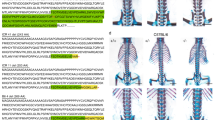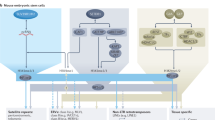Abstract
The recent discovery of a large number of histone demethylases suggests a central role for these enzymes in regulating histone methylation dynamics. Histone H3K27 trimethylation (H3K27me3) has been linked to polycomb-group-protein-mediated suppression of Hox genes and animal body patterning, X-chromosome inactivation and possibly maintenance of embryonic stem cell (ESC) identity. An imbalance of H3K27 methylation owing to overexpression of the methylase EZH2 has been implicated in metastatic prostate and aggressive breast cancers. Here we show that the JmjC-domain-containing related proteins UTX and JMJD3 catalyse demethylation of H3K27me3/2. UTX is enriched around the transcription start sites of many HOX genes in primary human fibroblasts, in which HOX genes are differentially expressed, but is selectively excluded from the HOX loci in ESCs, in which HOX genes are largely silent. Consistently, RNA interference inhibition of UTX led to increased H3K27me3 levels at some HOX gene promoters. Importantly, morpholino oligonucleotide inhibition of a zebrafish UTX homologue resulted in mis-regulation of hox genes and a striking posterior developmental defect, which was partially rescued by wild-type, but not by catalytically inactive, human UTX. Taken together, these findings identify a small family of H3K27 demethylases with important, evolutionarily conserved roles in H3K27 methylation regulation and in animal anterior–posterior development.
This is a preview of subscription content, access via your institution
Access options
Subscribe to this journal
Receive 51 print issues and online access
$199.00 per year
only $3.90 per issue
Buy this article
- Purchase on Springer Link
- Instant access to full article PDF
Prices may be subject to local taxes which are calculated during checkout




Similar content being viewed by others
References
Strahl, B. D. & Allis, C. D. The language of covalent histone modifications. Nature 403, 41–45 (2000)
Trojer, P. & Reinberg, D. Histone lysine demethylases and their impact on epigenetics. Cell 125, 213–217 (2006)
Cao, R. et al. Role of histone H3 lysine 27 methylation in Polycomb-group silencing. Science 298, 1039–1043 (2002)
Kuzmichev, A., Nishioka, K., Erdjument-Bromage, H., Tempst, P. & Reinberg, D. Histone methyltransferase activity associated with a human multiprotein complex containing the Enhancer of Zeste protein. Genes Dev. 16, 2893–2905 (2002)
Czermin, B. et al. Drosophila Enhancer of Zeste/ESC complexes have a histone H3 methyltransferase activity that marks chromosomal Polycomb sites. Cell 111, 185–196 (2002)
Muller, J. et al. Histone methyltransferase activity of a Drosophila Polycomb Group repressor complex. Cell 111, 197–208 (2002)
Wang, J., Mager, J., Schnedier, E. & Magnuson, T. The mouse PcG gene eed is required for Hox gene repression and extraembryonic development. Mamm. Genome 13, 493–503 (2002)
Plath, K. et al. Role of histone H3 lysine 27 methylation in X inactivation. Science 300, 131–135 (2003)
Heard, E. Delving into the diversity of facultative heterochromatin: the epigenetics of the inactive X chromosome. Curr. Opin. Genet. Dev. 15, 482–489 (2005)
Kotake, Y. et al. pRB family proteins are required for H3K27 trimethylation and Polycomb repression complexes binding to and silencing p16 INK4α tumor suppressor gene. Genes Dev. 21, 49–54 (2007)
Bernstein, B. E. et al. A bivalent chromatin structure marks key developmental genes in embryonic stem cells. Cell 125, 315–326 (2006)
Lee, T. I. et al. Control of developmental regulators by Polycomb in human embryonic stem cells. Cell 125, 301–313 (2006)
Varambally, S. et al. The polycomb group protein EZH2 is involved in progression of prostate cancer. Nature 419, 624–629 (2002)
Kleer, C. G. et al. EZH2 is a marker of aggressive breast cancer and promotes neoplastic transformation of breast epithelial cells. Proc. Natl Acad. Sci. USA 100, 11606–11611 (2003)
Klose, R. J., Kallin, E. M. & Zhang, Y. JmjC-domain-containing proteins and histone demethylation. Nature Rev. Genet. 7, 715–727 (2006)
Shi, Y. & Whetstine, J. R. Dynamic regulation of histone lysine methylation by demethylases. Mol. Cell 25, 1–14 (2007)
Yamane, K. et al. PLU-1 is an H3K4 demethylase involved in transcriptional repression and breast cancer cell proliferation. Mol. Cell 25, 801–812 (2007)
Iwase, S. et al. The X-linked mental retardation gene SMCX/JARID1C defines a family of histone H3 lysine 4 demethylases. Cell 128, 1077–1088 (2007)
Tahiliani, M. et al. The histone H3K4 demethylase SMCX links REST target genes to X-linked mental retardation. Nature 447, 601–605 (2007)
Secombe, J., Li, L., Carlos, L. & Eisenman, R. N. The Trithorax group protein Lid is a trimethyl histone H3K4 demethylase required for dMyc-induced cell growth. Genes Dev. 21, 537–551 (2007)
Klose, R. J. et al. The retinoblastoma binding protein RBP2 is an H3K4 demethylase. Cell 128, 889–900 (2007)
Eissenberg, J. C. et al. The trithorax-group gene in Drosophila little imaginal discs encodes a trimethylated histone H3 Lys4 demethylase. Nature Struct. Mol. Biol. 14, 344–346 (2007)
Christensen, J. et al. RBP2 belongs to a family of demethylases, specific for tri-and dimethylated lysine 4 on histone 3. Cell 128, 1063–1076 (2007)
Lee, M. G., Norman, J., Shilatifard, A. & Shiekhattar, R. Physical and functional association of a trimethyl H3K4 demethylase and Ring6a/MBLR, a polycomb-like protein. Cell 128, 877–887 (2007)
Liang, G., Klose, R. J., Gardner, K. E. & Zhang, Y. Yeast Jhd2p is a histone H3 Lys4 trimethyl demethylase. Nature Struct. Mol. Biol. 14, 243–245 (2007)
Seward, D. J. et al. Demethylation of trimethylated histone H3 Lys4 in vivo by JARID1 JmjC proteins. Nature Struct. Mol. Biol. 14, 240–242 (2007)
Ginalski, K., Rychlewski, L., Baker, D. & Grishin, N. V. Protein structure prediction for the male-specific region of the human Y chromosome. Proc. Natl Acad. Sci. USA 101, 2305–2310 (2004)
Greenfield, A. et al. The UTX gene escapes X inactivation in mice and humans. Hum. Mol. Genet. 7, 737–742 (1998)
Greenfield, A. et al. An H-YDb epitope is encoded by a novel mouse Y chromosome gene. Nature Genet. 14, 474–478 (1996)
Rinn, J. L., Bondre, C., Gladstone, H. B., Brown, P. O. & Chang, H. Y. Anatomic demarcation by positional variation in fibroblast gene expression programs. PLoS Genet. 2, e119 (2006)
Rinn, J. L. et al. Functional demarcation of active and silent chromatin domains in human HOX loci by noncoding RNAs. Cell 129, 1311–1323 (2007)
Boyer, L. A. et al. Polycomb complexes repress developmental regulators in murine embryonic stem cells. Nature 441, 349–353 (2006)
Pearson, J. C., Lemons, D. & McGinnis, W. Modulating Hox gene functions during animal body patterning. Nature Rev. Genet. 6, 893–904 (2005)
Issaeva, I. et al. Knockdown of ALR (MLL2) reveals ALR target genes and leads to alterations in cell adhesion and growth. Mol. Cell. Biol. 27, 1889–1903 (2007)
Wysocka, J. et al. WDR5 associates with histone H3 methylated at K4 and is essential for H3 K4 methylation and vertebrate development. Cell 121, 859–872 (2005)
Dou, Y. et al. Regulation of MLL1 H3K4 methyltransferase activity by its core components. Nature Struct. Mol. Biol. 13, 713–719 (2006)
Cho, Y. W. et al. PTIP Associates with MLL3- and MLL4-containing histone H3 lysine 4 methyltransferase complex. J. Biol. Chem. 282, 20395–20406 (2007)
Ayton, P. M. & Cleary, M. L. Transformation of myeloid progenitors by MLL oncoproteins is dependent on Hoxa7 and Hoxa9 . Genes Dev. 17, 2298–2307 (2003)
Raman, V. et al. Compromised HOXA5 function can limit p53 expression in human breast tumours. Nature 405, 974–978 (2000)
Chan, J. et al. Morphogenesis of prechordal plate and notochord requires intact Eph/ephrin B signaling. Dev. Biol. 234, 470–482 (2001)
Acknowledgements
HeLa nucleosomes were a gift from X. Shi and O. Gozani. We thank G. Schnitzler for discussion. J.L.R. is a Fellow and H.Y.C. is the Kenneth G. and Elaine A. Langone Scholar of the Damon Runyon Cancer Research Foundation. J.R.W. is a recipient of the Ruth L. Kirschstein National Service Award. This work was supported by grants from the National Science Foundation (to J.K.W.), NIH, Scleroderma Research Foundation and Emerald Foundation (to H.Y.C), and from the NIH to Y.S. This work was also supported in part by a grant from the Novartis Biomedical Research Institute (to Y.S).
ChIP-chip data have GEO accession number GSE8855.
Author information
Authors and Affiliations
Corresponding author
Ethics declarations
Competing interests
Reprints and permissions information is available at www.nature.com/reprints. The authors declare no competing financial interests.
Supplementary information
Supplementary Information
The file contains Supplementary Figures S1-S8 with Legends and Supplementary Tables 1-3. (PDF 870 kb)
Rights and permissions
About this article
Cite this article
Lan, F., Bayliss, P., Rinn, J. et al. A histone H3 lysine 27 demethylase regulates animal posterior development. Nature 449, 689–694 (2007). https://doi.org/10.1038/nature06192
Received:
Accepted:
Published:
Issue Date:
DOI: https://doi.org/10.1038/nature06192
This article is cited by
-
The role of H3K27me3 methylation in cancer development
Genome Instability & Disease (2024)
-
Novel long non-coding RNAs associated with inflammation and macrophage activation in human
Scientific Reports (2023)
-
KDM6 demethylases integrate DNA repair gene regulation and loss of KDM6A sensitizes human acute myeloid leukemia to PARP and BCL2 inhibition
Leukemia (2023)
-
Identification of unique DNA methylation sites in Kabuki syndrome using whole genome bisulfite sequencing and targeted hybridization capture followed by enzymatic methylation sequencing
Journal of Human Genetics (2022)
-
The histone demethylase Kdm6b regulates subtype diversification of mouse spinal motor neurons during development
Nature Communications (2022)
Comments
By submitting a comment you agree to abide by our Terms and Community Guidelines. If you find something abusive or that does not comply with our terms or guidelines please flag it as inappropriate.



